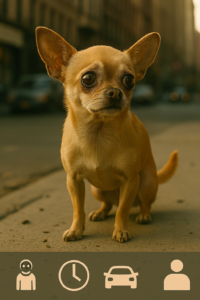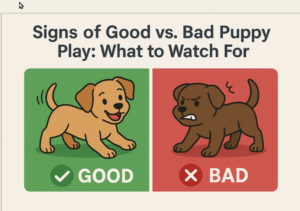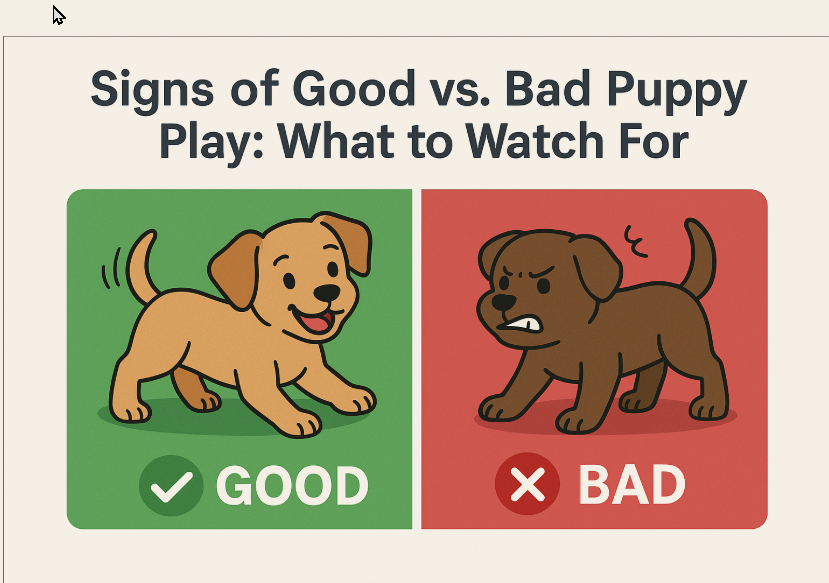
Signs of Good vs. Bad Puppy Play: What to Watch For
Puppies love to play—but not all play is created equal. Here’s how to recognize when your pup is having fun vs. when it’s time to step in.
Why Puppy Play Matters
Puppy play is more than just adorable entertainment—it’s essential to development. Play teaches puppies how to interact, communicate, and form relationships. As veterinarian and behaviorist Dr. Sophia Yin explains, “Proper socialization and play are key to developing a confident, balanced, and well-adjusted dog.”
Good Puppy Play: What to Look For
- Play bows: A clear invite, where a puppy lowers their front legs and wags their tail
- Gentle mouthing: Soft bites that don’t hurt or leave marks
- Back-and-forth chasing: Puppies take turns being the chaser and the chased
- Playful sounds: Happy barks and short growls in a relaxed tone
- Relaxed body language: Loose movements, wagging tails, and no signs of fear
Example: If your puppy and a playmate are joyfully tugging a toy and swapping roles with tails wagging, that’s healthy, balanced play.

Bad Puppy Play: Red Flags to Watch
- Snarling and intense biting: Growling with stiff posture or biting that causes injury
- One-sided dominance: One puppy repeatedly pins the other or won’t let them escape
- Overexcitement: Frantic jumping, barking, and ignoring calming signals
- Fearful behavior: Tucked tail, flattened ears, hiding or trying to escape
Example: If your pup keeps tackling another puppy who’s trying to hide or whimpering, it’s time to step in and redirect the energy.
Common Misunderstandings About Puppy Play
Play can look rough, but that doesn’t always mean it’s bad. Teething puppies often nip during excitement—it’s natural but should be managed. If your pup lightly nips and responds when corrected, that’s normal behavior. Persistent, hard biting or ignoring cues is where it crosses the line.
How to Monitor and Intervene
- Supervise all play sessions, especially with unfamiliar dogs
- Use cues like “gentle” or “enough” to guide behavior
- Keep sessions short—5 to 15 minutes works best
- Offer toys or treats to redirect when needed
Example: If Max is getting overstimulated, call him away and give him a chew toy or ask him to sit for a treat break.

Tips for Encouraging Positive Puppy Play
- Choose suitable playmates: Match puppies by size, energy, and temperament
- Join socialization classes: Trainers help mediate and model good behavior
- Offer a mix of toys: Use tug ropes, balls, and puzzle toys to keep play varied
Example: In puppy class, shy Charlie slowly learns to engage by watching calm dogs and mimicking their movements.
Long-Term Benefits of Healthy Play
Well-socialized puppies grow into confident, adaptable dogs. They’re more likely to respond to commands, less prone to aggression, and better adjusted to new environments. Consistent, positive play lays the foundation for a lifetime of good behavior.
Conclusion
Understanding the difference between good and bad puppy play keeps your pup safe and happy. With supervision, the right environment, and thoughtful guidance, you can encourage healthy habits that stick for life. 🐾
What toys are best for puppy play?
Soft tug toys, small balls, and chewable puzzle toys are ideal. Avoid anything too hard or small that could pose a choking risk.



